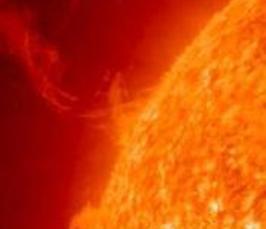ESP Online Seminar: Understanding hooks of solar flare ribbons and the evolution of coronal mass ejections (Juraj Lorinčík)
ESPOS
- Date: May 28, 2020
- Time: 11:00 AM - 12:00 PM (Local Time Germany)
- Speaker: Juraj Lorinčík
- Astronomical Institute of the Czech Academy of Sciences
- Location: Max-Plack-Institut für Sonnensystemforschung
- Room: Zoom
- Host: Pradeep Chitta

Solar flares and eruptions are one of the most energetic phenomena occuring in the solar system. They are typically described by the cartoon-like 2D Standard model of solar flares. This model is however not capable of describing J-shaped (hooked) solar flare ribbons, bright elongated structures typically observed in the UV part of the spectrum. Their description requires 3D MHD modelling of magnetic flux ropes, bundles of twisted field lines rooted in the hooked endings of flare ribbons. The standard flare model in three dimensions, developed in the Observatory of Paris, was recently used to find predictions on how do the field lines reconnect during solar eruptions with respect to the positions of flare ribbons (Aulanier & Dudík 2019, A&A, 621, 72). Authors of this study identified three geometries involving field lines composing and/or surrounding the erupting flux rope. With a help of high-resolution EUV data, these were identified in a series of publications focused on eruptive events. Using data from the Atmospheric Imaging Assembly (AIA) onboard the Solar Dynamics Observatory, we will present the manifestations of the different 3D reconnection scenarios and discuss under what conditions can their constituents be observed. We present the application of the weighted horizontal gradient of magnetic field (WGM) flare prediction method to 3D extrapolated magnetic configurations of flaring solar ARs. The main aim is to identify an optimal height range, if any, in the interface region between the photosphere and lower corona, where the flare onset time prediction capability of WGM is best exploited. The optimal height is where flare prediction, by means of the WGM method, is achieved earlier than at the photospheric level. 3D magnetic structures, based on potential and non-linear force-free field extrapolations, are constructed to study a vertical range from the photosphere up to the low corona with a 45 km step size. We found that applying the WGM method between 1000 and 1800 km above the solar surface would improve the prediction of the flare onset time by around 2-8 hrs. Certain caveats and an outlook for future work along these lines are also discussed.